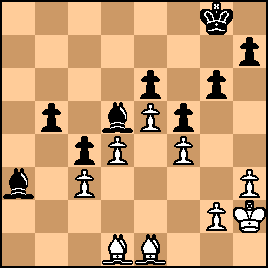| Apr-23-24 | | generror: I was wondering why 1.d4 d5 2.c4 c6 3.Nf3 Nf6 4.Nc3 g6 is called the Schlechter variation when it was apparently first played (via transposition) here, by Blackburne, against him. However, he seemed to have been impressed by the idea and tried it successfully in Karlsbad 1911: F Duz-Khotimirsky vs Schlechter, 1911 |
|
Apr-23-24
 | | MissScarlett: < Carl Schlechter, who had drawn a match for the World Championship with Emanuel Lasker in 1910, prepared the eighth and final edition. Published in eleven parts between 1912 and 1916, it totaled 1,040 pages and included contributions by Rudolf Spielmann, Siegbert Tarrasch, and Richard Teichmann. International Master William Hartston called it "a superb work, perhaps the last to encase successfully the whole of chess knowledge within a single volume."> https://en.wikipedia.org/wiki/Handb... Blackburne's contribution to chess literature was practically zero. Note that I'm not implying that Schlechter used his position to take credit for the ideas of others. |
|
Apr-23-24
 | | beatgiant: By far the most high profile early example of a ...g6 Slav is Lasker vs Schlechter, 1910, although we list that game as Quiet Variation instead of Schlechter Variation. |
|
| Apr-24-24 | | vonKrolock: Tarrasch vs Alapin, 1892 |
|
| Apr-28-24 | | generror: <MissScarlett>, I don't think Schlechter named this variation after him, that was surely done retroactively. <beatgiant> and <vonKrolock>, thanks for the games :) |
|
| Apr-29-24 | | vonKrolock: Regarding <4...g6> as played by him in the tenth game of the match vs Lasker in 1910, Schlechter (in the "Bilguer" edition of 1916) says just that it <" in Betracht kommt"> ('can be considered') and nothing more. And about <4...Qb6> : he names it <"Süchtings Zug"> and quotes Schlechter vs H Suechting, 1911 |
|
| Apr-29-24 | | vonKrolock: <and nothing more> except a few moves of the aforementioned Lasker vs Schlechter Berlin 1910 game of course |
|
| Apr-30-24 | | generror: Daaaamn, that's right, thanks for pointing that out.... what a crazy game! And I just realized that I pointed out in my comment to that game that it coined the name for the "Schlechter Variation", hahahaha... not sure if I had any sources for that (probably not). But that game sure is the most memorable and high-profile early one with <4...g6>, even though it's not officially a Schlechter Defense because that damn Lasker played <4.e3>. |
|
| Apr-30-24 | | unferth: looks like 39 Qxa3 followed by Be1 holds the draw, doesn't it? |
|
| May-01-24 | | FM David H. Levin: <unferth: looks like 39 Qxa3 followed by Be1 holds the draw, doesn't it?> I don't think so. After 39. Qxa3 Bxa3 40. Be1,

click for larger viewBlack should be able to win by a timely ...b4 as in the game. But as Black I'd start by containing the White king: 40...Bc1 41. Kg3 Be3! (Intending 42. Bf2 Bd2.) 42. Bf3 Be4! 43. Bxe4 fxe4 
click for larger view44. Kh2 Kf7 (Ignoring the f-pawn in order to bring Black's king within the "square" of the soon-to-be-created White pawn on b4.) 45. g3 b4 46. cxb4 Bxd4 47. Kg2 e3 48. Kf3 c3, and White must give up the bishop in order to prevent ...c2 and ...c1=Q. |
|
| May-01-24 | | unferth: thanks! the idea of corralling the white king hadn't occurred to me--but I'm still not seeing how black makes progress after 40 ... Bc1 41 g3. seems to me that if black continues with Be3 to confine the king, white can reply with Bc2, and if black attempts to swing his king to the queenside to enforce the b4 break, white can mark time with Bc2-Bb1-Bc2. if black moves either bishop to a new diagonal, the white king escapes in time to intervene on the queenside. am I missing something? I'm just an engine-free club player, so probably yes... |
|
| May-01-24 | | unferth: on further review, I guess black can simply walk his king to the queenside and, after a timely Bf3 & Bd1, use zugzwang to force a road into the enemy camp. |
|
| May-02-24 | | FM David H. Levin: <unferth: on further review, I guess black [after 39. Qxa3 Bxa3 40. Be1 Bc1 41. g3 Be3] can simply walk his king to the queenside and, after a timely Bf3 & Bd1, use zugzwang to force a road into the enemy camp.> There might be more than one way for Black to win after that continuation. 
click for larger viewMy inclination would be to bring Black's king to d5 and then break with ...b4:
42. Bc2 Kf7 43. Bd1 Be4 44. Be2 Ke7 45. Bd1 Kd7 46. Be2 Kc6 47. Bd1 Kd5 48. Be2 b4 49. cxb4 Kxd4, 
click for larger viewand White will soon have to give up a bishop for the c-pawn. |
|





































